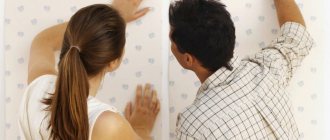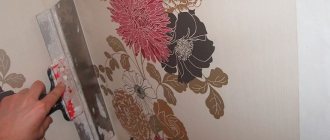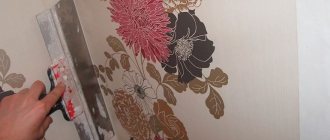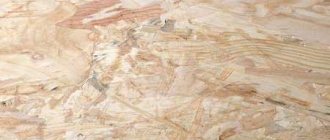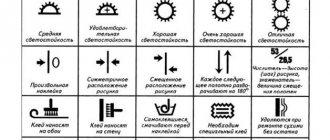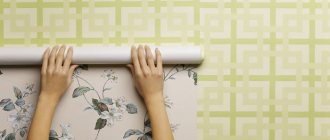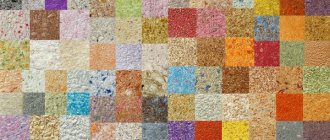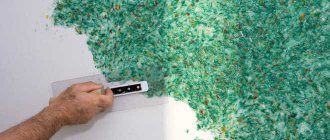Today we will look at a topic such as gluing non-woven wallpaper with vinyl glue. Is this possible and what difficulties may arise when wallpapering with the wrong glue?
If you still have glue left after the repair, then you are probably thinking about using it for further work. But what to do if your wallpaper that you are going to glue is non-woven, but the glue remains vinyl. Is it worth the risk or is it better to buy new glue?
Of course, any specialist will tell you that it’s not worth the risk and that it’s better to buy glue that’s suitable for your wallpaper, especially since glue isn’t that expensive. This way you will avoid the consequences that may arise.
However, in the case of vinyl glue and non-woven wallpaper, not everything is so scary, so it may be worth the risk. The density of non-woven and vinyl wallpapers is quite the same, so the adhesive composition will not differ much. But difficulties may still arise, which we will discuss below.
What can happen when gluing non-woven wallpaper with vinyl glue
By and large, it is quite difficult to guess what exactly can happen when choosing the wrong wallpaper glue, because there are many factors at play here. There are different types of non-woven wallpaper, and there are different types of vinyl adhesive. There is also a universal glue that should be suitable for any decoration option.
- Firstly, the glue can deform your pattern or texture of non-woven wallpaper.
- Secondly, when gluing wallpaper end to end, as the glue dries, seams may form that will need to be repaired later.
By and large, it is difficult to say exactly how paper wallpaper will react to glue for non-woven wallpaper. What matters here is the density of your non-woven wallpaper.
- If the wallpaper is very thin and simple, then glue for vinyl wallpaper can be harmful.
- If the non-woven wallpaper is thick enough, then perhaps everything will go smoothly.
Either way, you're taking a risk.
Which glue to choose
The glue is made on the basis of modified starches and, depending on the type of additives, can have different properties.
Usually, in the store, the consultant manager offers glue that will suit the selected wallpaper. He will also tell you whether glue for non-woven models can be used for vinyl ones.
For non-woven products, it has the form of a dry powder packaged in paper packaging. Before use, you must dilute it in water and stir for 5-10 minutes.
When ready, the glue looks like thick sour cream without lumps. To make sure it is ready, you can try applying it to the surface.
After the first spreading, the layer should be smooth and uniform.
If we compare the consumption, we can say with confidence that vinyl wallpaper requires approximately 2 times less glue than non-woven wallpaper.
Models with a two-layer coating have a sliding effect, which greatly simplifies the process.
How to prepare walls for wallpapering
Of course, preparing walls for wallpapering takes up quite a large place in renovation work.
If your walls are not prepared, the end result may not be what you would like. Therefore, it is worth properly preparing the walls before gluing wallpaper.
- First of all, the walls need to be leveled. Any deviation of the walls from the vertical position is a problem. Subsequently, as soon as you arrange the furniture, especially tall cabinets in the corners, you will have a situation where the cabinet stands strictly vertically, and the seam between the cabinet and the wall is different, due to the fact that the wall has a deviation. It is also worth leveling out any small defects such as bumps or pits. To do this, the walls are primed and then covered with plaster.
- The next step in preparing walls for wallpapering is priming followed by applying putty, which will make your walls as smooth as possible and suitable for decoration.
- Next, you need to clean the walls, smoothing out all the small irregularities that arose during the application of plaster and putty.
- The last step in preparing walls for gluing is applying a finishing primer, which will create a good layer so that the wallpaper sticks confidently to the walls and does not peel off.
Differences
In addition to the main difference related to air circulation, these 2 types differ in the method of applying glue.
If it is vinyl, you need to lubricate the surface of the wallpaper directly, but in the case of non-woven wallpaper, it is enough to apply the adhesive to the wall.
In terms of time and complexity of repair work, vinyl ones clearly lose. They are much easier to care for because they can be wiped with a damp sponge to remove dirt. This can no longer be done with non-woven fabrics.
What are the differences between non-woven wallpaper and vinyl?
Since we're talking about glue, it's worth saying a few words about wallpaper. What are the general differences between non-woven wallpaper and vinyl?
In addition to some aspects in the composition that do not play a big role, there is one fat nuance.
Vinyl wallpaper is the same non-woven wallpaper, but with a special film in the form of a top covering layer, which does not allow the wallpaper to breathe and allow moisture to pass through, and also helps in caring for the wallpaper, because it can be washed.
Vinyl adhesive allows the wallpaper to slide slightly along the walls, making it convenient to align it with the adjacent sheet. There is only one caveat: when gluing vinyl wallpaper with vinyl glue, it is recommended to apply the glue to both the wall and the wallpaper. And when gluing non-woven wallpaper with non-woven glue, it is recommended to apply the glue only to the wall. If you are gluing non-woven wallpaper with vinyl glue, we recommend applying vinyl glue only to the wall, otherwise the wallpaper may strongly absorb moisture from the glue and become deformed.
By and large, there is not much difference between the two types of wallpaper, so the composition of the glue is not much different. Of course, we recommend buying the right glue, but in the absence of one, or if you want to save money, there is nothing wrong with using vinyl glue for gluing non-woven wallpaper. However, you are taking a risk one way or another, so decide for yourself.
Advantages
The fundamental feature of this type is that vinyl consists of two layers:
- Polyvinyl chloride film;
- Paper base.
The first layer is designed to protect against mechanical damage and has excellent water-repellent properties. The bottom layer is made of paper and sometimes non-woven base.
If you take care of such wallpaper, it can last a long time.
They are characterized by easy cleaning and the ability to hide minor wall irregularities.
To significantly extend their “life” and prevent the formation of mold on them, before gluing, it is necessary to treat the wall with a high-quality antiseptic emulsion.
The main disadvantage of vinyl wallpaper is the lack of air circulation.
Due to the fact that the top layer consists of PVC foam, the wall is practically insulated, which creates an ideal microclimate for the formation of dampness and fungal growth.
The market offers vinyl models that have micropores in the upper part that allow air to pass through. An interesting proposal, but it does not solve the problem 100%.
Conclusions on the topic
Thus, we became acquainted with the topic of whether it is possible to use vinyl adhesive for gluing non-woven wallpaper. By and large, both vinyl and non-woven wallpapers, with rare exceptions, are quite dense, so their adhesive strength will be very similar. If you decided to glue cheap paper wallpaper with vinyl glue, then difficulties would be inevitable. In the case of gluing non-woven wallpaper with vinyl glue, everything should go well, however, if you are gluing expensive non-woven wallpaper, then we recommend not saving, but using glue that is suitable for the specific wallpaper. This way you will protect yourself, because remember - the stingy pays twice.
If you want to share your experience or have any questions on this topic, then we are waiting for you in the comments to this article. Tell us how your wallpaper is doing and ask your questions, and our authors and readers will answer you.
Happy renovation!
Compatibility
And again the question arises, is it possible to glue vinyl wallpaper with non-woven glue? The answer is quite simple - you can.
There is no fundamental difference between types of glue. The only difference is the amount and type of additives.
If the manufacturer recommends a certain glue, then it is 100% suitable. But you can use others too.
To glue paper-based models with non-woven glue, it is enough to make it more liquid.
The only option for poor fit is the use of glue for paper-based models with non-woven ones.
Components of most types of glue:
- Modified starch;
- Methylcellulose;
- Antifungal additives.
Useful tips
When choosing wallpaper, consider the type of room and the condition of the walls. For the living room, bedroom, corridor and other rooms where the walls are dry and smooth, any type of wallpaper is suitable. For rooms with high humidity: kitchen, bathroom and toilet - choose washable vinyl wallpaper. The shortcomings of uneven walls will be hidden by textured wallpaper, as well as wallpaper with large cells or a dense pattern.
To trim the edges smoothly above the baseboard and below the ceiling, do this before the glue dries. Use a spatula as a stop and keep the cutter horizontally, otherwise the paper may accidentally tear. Useful life hack: to avoid scraping hardened glue from the knife, rinse it with hot water before cutting the edges.
Beginners are generally intimidated by wallpapering, and when they see a battery that cannot be removed, this is a real reason to panic. In fact, everything is not so scary: cut the wallpaper in the places where the pipes are supplied and the battery is attached, stick the wallpaper according to the instructions above, and smooth out the unevenness with a mop wrapped in a clean rag, remove traces of glue. Done, you are amazing!
That's all. As you can see, wallpapering is not as scary a process as it seems at first. Only those who don't try fail. We wish everything goes well and easily for you!
Non-woven vinyl wallpaper: reviews
If you analyze the reviews, you can roughly make a list of the advantages and disadvantages of wallpaper, which are most often noted by customers.
Pros and cons of non-woven vinyl wallpaper:
- Pros - wallpaper is durable, highly abrasion-resistant, high-quality, impressive in appearance, affordable, easy to care for, large selection.
- Cons - problems may arise with the glue; sometimes even the wrong proportions are indicated on the glue packaging, which is why heavy wallpaper falls off.
Related article: Plastic window profiles: compare and choose the best
Judging by the reviews, you can’t skimp on glue, and some even prefer to dilute wallpaper glue with PVA glue, assuring that a thicker composition holds the wallpaper better.
As for brands, German and Italian wallpapers are held in the highest esteem. Italy is famous for keeping up with fashion and even being ahead of it.
A rich palette of colors and prints, imitation of natural materials (sometimes it seems that this is not wallpaper at all, but expensive fur), design for a specific interior style - all this is Italy, its quality and style
Germany is all about advanced technology and refined taste. And German wallpaper, and if the manufacturer is Italy, will not cost, let’s say, three kopecks. Therefore, if you are assured that the wallpaper is branded, Italy, the latest collection, but a roll costs three hundred rubles, is it worth talking about quality?
Gluing process
In order to significantly simplify the gluing process and ensure a longer service life, it is necessary to carefully prepare the working surface - the wall.
To do this, all existing layers of previous coatings are removed from it. The wall is leveled using putty, and after that a special high-quality primer is applied.
For convenience and a successful start to the process, you need to draw a vertical line on the wall. This can be done using an ordinary pencil.
The next step is to prepare the wallpaper fragments for subsequent gluing.
If the ceilings are smooth and the height is the same along the entire wall, then you can immediately cut the required number of fragments, adding 2 cm of reserve to each of them.
Otherwise, you need to cut off 1 sheet at a time and take the measurements again each subsequent time.
The glue must be prepared according to the instructions that usually come with the kit. For application, you can use a soft brush or roller of a convenient size.
When applying glue, it is better to start from the middle and gradually move towards the edges. Be sure to give it a couple of minutes to soak, this will significantly improve the quality of adhesion to the wall.
Of course, it is better to purchase glue along with the wallpaper, following the advice of an experienced sales consultant.
Please watch the video on the topic:
If for some reason vinyl wallpaper and non-woven glue are in stock, then this is not a reason to be upset. It will fit quite well and will last quite a long time.
Preparing the walls
Once you have figured out whether vinyl wallpaper can be glued with non-woven adhesive, you should check the walls, which should be clean, dry and free of cracks. If defects are found, they must be covered with putty.
The surface should absorb moisture normally. To check this characteristic, the wall must be sprayed with water. If drops remain on the surface, then absorbency is reduced. In this case, the surface is peeled off with wallpaper paper.
If the splashes form dark spots and remain on the wall, then the absorbency is too high. In order to eliminate problems, it is necessary to apply a paste, primer or wallpaper glue.
Top 7 best brands
| Name | Description |
| French brand Kleo | The product line includes many adhesive products for different types of coatings. For vinyl wallpaper there is a universal adhesive with modified starch as a base. |
| German brand Pufas | Offers a product based on methylcellulose, which is suitable for the densest and heaviest wallpaper. It mixes perfectly smoothly, quickly turning into a homogeneous mass without lumps. Hypoallergenic |
| Another “German” Metilan | Starch based. The composition also contains an indicator, which turns pink when in contact with the surface. This allows you to apply the substance evenly without gaps. |
| French product "Quelyd special vinyl" | Recommended for rooms with high humidity levels for gluing heavy-weight canvases. Judging by this characteristic, it is suitable in the most difficult situations. Costs more than its analogues |
| "Moment" | A well-known German drug that includes both methylcellulose and modified starch. Of the above five, it is the most optimal in terms of price-quality ratio |
| Domestic glue “Quality” | Modified potato starch costs only 75 rubles for 300 grams of powder. It dilutes well, without forming lumps |
| English brand "Exclusive Axton" | Offers an excellent product based on the same starch, which users call the most economical for its low consumption. True, the heaviest canvases should be glued to another product |
Properties of vinyl sheets
Vinyl coating is a polymer layer that is applied to a base made of paper or non-woven fabric. The main advantage of this material is its long service life. In addition, vinyl does not fade under the influence of ultraviolet rays, as happens with other wallpapers, so you can safely choose canvases with bright patterns. In addition, the coating does not deform under the influence of moisture, so the linens are even used for toilets and bathrooms.
However, the polymer coating does not withstand temperature fluctuations the best, so it is not recommended to glue the sheets near the stove or other heat sources.
This material does not allow oxygen to pass through. This problem can be corrected by purchasing special cloths with microscopic holes. Only in this case will the wallpaper be breathable, but at the same time maintain protection from moisture.
Vinyl coating is wear-resistant
Some people are inclined to believe that polymer coating can harm the well-being of residents. This belief arose for a reason, but only low-quality materials have such properties, so it is recommended to avoid products from dubious manufacturers. While high-quality vinyl sheets do not pose harm to households, because they are produced in accordance with safety standards.
The positive aspects of vinyl covering include the following:
- Possibility to apply wallpaper to any type of surface (wood, plaster, concrete).
- The canvases have a significant thickness, due to which they hide damage to floors and sagging plaster (to hide defects, you need to use canvases with maximum density).
- A choice of colors allows you to find the best option for each design.
- If necessary, you can choose both standard rolls and those with a width of 100 centimeters.
Vinyl sheets are designed for surfaces of any type
This is interesting: Insulation for indoor house walls and features of choice: we present them in order
Master class for beginners
Before starting work, you need to prepare the walls by removing the old coating from them. It is convenient to use a special machine that creates micro-punctures. Firmly adhered flaps are soaked and removed with a spatula. The day before pasting, it is recommended to soak the walls with 1-2 layers of primer.
Before starting work, switches and sockets are also removed, and the old baseboard is removed
During the work you need to do the following:
Spread the new wallpaper on the floor, make markings and cut off the strips with a utility knife. The length of the canvases is equal to the height of the walls plus 1 cm. Dilute the glue with water, checking the instructions on the package. Mix the mixture thoroughly, rubbing out any lumps. It is convenient to apply glue from a construction ditch with a limiter that removes excess product. You need to start pasting from the window. The canvases are placed end-to-end, without overlap. Determine the location of the first strip using a building level
This is especially important for coatings with a vertical line pattern. Coat the wall with glue, apply a strip of wallpaper, pressing it with your hands against the ceiling. Make sure that the edge of the canvas lies exactly according to the markings
While the glue is not fixed, dense products can be moved, unlike paper ones, they will not tear or get wet. Roll the glued strip with a wide roller from top to bottom. After making sure that the canvas is fixed, smooth out wrinkles and bubbles with a rag, moving sideways. Having removed the irregularities, proceed to gluing the second strip. Roll the joints with a small rubber roller and wipe off any glue drops with clean rags. At the junction of the ceiling and wall, cut off excess wallpaper with scissors or a knife. If the fabric comes off, add a little glue and roll the strip with a roller. For greater density, the joint can be treated with a stiff brush, moving it from bottom to top. If the strip goes to an angle, roll it with a roller, and then smooth out small irregularities with a soft rag. You need to act quickly so that the glue does not have time to set. After gluing the removed switches and sockets, make cross-shaped cuts and carefully remove excess pieces of fabric. After finishing the work, wait for the glue to dry completely. After this, you can attach floor and ceiling skirting boards, install sockets and switches.
Wallpaper base
To hang wallpaper yourself quickly and efficiently, you will need information about the tools and equipment available in wall covering and adhesive stores. If you have calculated your strength and are ready to get to work, then you should stock up on:
- quality materials;
- reliable tools;
- desire;
- information about the correct technology for wallpapering.
Violation of technology inevitably leads to the fact that the first sheet lies crookedly or the angle turns out to be sloppy, and you do not achieve the desired effect.
First of all, you need to know on what surface you can stick the wallpaper. After all, all the rooms in the house have different wall coverings: the hallway may have painted walls, the living room may have decorative plaster, and the bedroom may have been wallpapered 10 years ago.
All surface imperfections must be removed:
- remove sagging;
- seal cracks with putty;
- pull out metal products - nails, dowels, embedded parts.
The wall must be free of defects, because they will definitely appear through the sheets: sagging will stick out, sheets will peel off due to cracks, and rusty stains will appear on the metal.
In new buildings, preparing the surface for cladding does not cause any special problems. Gluing wallpaper to concrete walls is quite simple; to do this, perform a complex of the following work: eliminate unevenness, prime and putty the walls, then prime again. What to do if there is old cladding. In this case, its dismantling will depend on the type of material with which the walls are covered.

